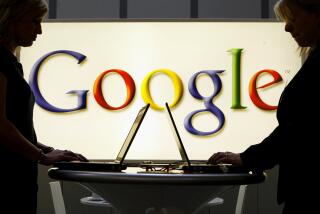Blame a dysfunctional patent system for Apple vs. Samsung verdict
- Share via
Whether you think that Apple is already too big for its britches or that Samsung deserved to get slammed for $1 billion by a Silicon Valley jury last week for infringing on the iPhone design, there’s no doubt where the blame for this corporate firefight lies.
The guilty party is the U.S. Patent Office.
Actually, that’s a bit unfair. The Patent and Trademark Office, as it’s formally known, is understaffed and underfunded and not especially up to the task of judging increasingly complex patent applications. But the real problem is in the law, which utterly has failed to keep up with realities of technology and the marketplace.
“Apple v. Samsung is just a proxy for everything else that’s wrong with the patent system right now,” says Julie Samuels, an attorney with the Electronic Frontier Foundation, which is campaigning to reform the system.
The system’s biggest problem is with software patents of the sort that underlie Apple’s lawsuit against Samsung. Apple charged that Samsung infringed its patents on such software-based iPhone features as its tap-to-zoom function, while copying its devices’ appearances to “confuse” shoppers.
In the information technology field the patent process has ceased to become a way to encourage and reward innovation. Instead, it’s a competitive weapon, which was not the original idea at all.
It’s become a means of providing “a windfall to the [patent owner] and a form of punitive rather than compensatory damages imposed on the infringer,” wrote Chicago federal appeals judge Richard Posner in June. Posner, perhaps the most thoughtful member of the appeals bench and a sharp critic of patent practice, made the point when he tossed out an Apple patent lawsuit against Motorola that was virtually a clone of the Samsung case.
Until about 1980, software was thought to be unpatentable because it didn’t seem to fit into patentable categories such as “machines” or “processes.” But following a series of ambiguous federal court decisions, the ground shifted. By the 1990s software patents were common.
But the law is still as ambiguous as ever. With competition in multibillion-dollar markets resting on such shaky bedrock, the risk of earthquakes is high.
Software patents tend to be both broad and vague, which means their owners can assert claims of alleged infringement against inventions not remotely anticipated by the original claims. “Software is a building block technology — you write code and someone improves upon it,” Samuels observes. Where does the patented invention end and the augmentation begin? Drawing the line can be difficult.
Today’s digital devices are assembled from numerous pieces — the iPhone isn’t based on one patent, but scores. Posner wrote in his Motorola ruling that technology cases typically involve fights over “minor features in complex devices most features of which are not alleged to infringe.”
That creates a problem of enforcement. Forcing Samsung to stop selling its Galaxy phones because you can tap the screen to zoom the display of a document is overkill, and a huge burden on consumers who already bought the phone and might need it repaired or replaced. Yet Apple is asking the judge in the Samsung case to ban eight Samsung devices from sale in the wake of the verdict.
The patent office has dumped these complexities into courts’ laps. Patent examiners could have put the kibosh on the Samsung case by asking such questions as these before approving Apple’s patent claims: Are the rows of icons on the iPhone really revolutionary? Is tapping a touch screen to execute a command really a patentable innovation? Is making a hand-held phone flat and rectangular with rounded corners a unique idea such that all other flat and rectangular phones with rounded corners should be pulled off the shelves?
The illogic of the patent system is what generates nonsensical verdicts like last week’s jury award. Apple’s allegation that Samsung copied the iPhone with its phones is virtually identical to its allegation that Samsung copied the iPad with its Galaxy tablet computer. In its briefs, Apple describes both of its devices as “a rectangular product with four evenly rounded corners, a flat clear face covering the front of the product, a large display screen under the clear surface … and a matrix of colorful square icons with evenly rounded corners,” etc., and alleges that Samsung copied these “distinctive” features.
The San Jose jury found that the Samsung phones copied the iPhone, but also that the Galaxy tablet didn’t copy the iPad. What’s the differentiating factor? It didn’t say.
Not only juries get lost in the patent labyrinth, but the judicial system as a whole. Posner found Apple’s claim that Motorola’s alleged patent infringements had cost it market share and consumer goodwill to be “implausible.” He pointed out that Apple had failed to present even a “minimally adequate” case for damages.
The San Jose jury seemed blindly to accept Apple’s position that customers routinely walked out of electronics stores with Samsung phones, confused into thinking they’d bought iPhones. There may be some consumers dimwitted enough to make that mistake, but it’s unlikely they could have cut into Apple’s sales by a billion dollars.
One notable irony of Apple’s fortress-of-patents strategy is that the company’s own signature innovation was quite possibly based on theft. That’s the graphical display feature of its pioneering Macintosh computer. The originator of the graphical display was Xerox Corp.’s Palo Alto Research Center, or PARC, which in 1979 gave Apple co-founder Steve Jobs and the design team of Apple’s Lisa computer, the Mac’s precursor, a super-secret demonstration of the technology.
Dazzled by the screen display he saw at PARC, Jobs ordered the designers to put something just like it into the Lisa, and subsequently the Mac. That didn’t stop Jobs from suing Microsoft in 1988 for allegedly poaching the Mac interface to create Windows. But it did elicit this classic comeback from Bill Gates, published in a trade magazine in 1989: “Steve, just because you broke into Xerox’s house before I did and took the TV doesn’t mean I can’t go in later and take the stereo.”
Plainly, if software had been judged patentable in 1979 and Xerox had taken the aggressive approach common today, it could have blasted Apple into the asteroid belt. Jobs wouldn’t be a lionized figure today, but a tech industry footnote.
It’s unlikely that software patents will disappear any time soon, or ever. But there are other ways to fix the system. Posner has argued that some industries deserve more patent protection than others. Pharmaceutical companies, for example, can spend millions to bring a product to patentable form, and then consume 10 years of its 20-year patent in testing before it’s approved for sale; so drugs arguably deserve full patent protection.
Software, on the other hand, is cheaper to develop and easy to place on the market. Giving it 20 years of protection can only stifle creativity and competition.
On those grounds, the Electronic Frontier Foundation proposes to cut software patents to five years; prevent damages from being based on the entire market value of a product when only a small piece of it infringes; and require much more detailed and narrow applications in software cases. That would be a start to rectifying a dysfunction in the patent system that has been developing for more than 20 years, and certainly to prevent absurd verdicts like the one handed down last week in San Jose.
Michael Hiltzik’s column appears Sundays and Wednesdays. Reach him at mhiltzik@latimes.com, read past columns at latimes.com/hiltzik, check out facebook.com/hiltzik and follow @latimeshiltzik on Twitter.
More to Read
Inside the business of entertainment
The Wide Shot brings you news, analysis and insights on everything from streaming wars to production — and what it all means for the future.
You may occasionally receive promotional content from the Los Angeles Times.










